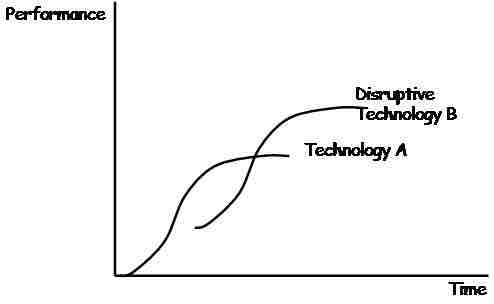Technology and Management
Managing technology is an intrinsic part of managing a business, and effectively balancing resources to optimize efficiency is an important operational objective for all managers. Varying perspectives and strategies in technology management abound, all revolving around a few simple needs being filled to move the business towards a competitive advantage. The reason behind the prioritization of technology management is that new, disruptive technology constantly threatens to result in higher efficiency of competitors. On the other hand, effectively managed technology affords businesses the opportunity to outpace the competition (see figure below).

Disruptive technology
This graph underscores the concept that technology advancement is both a constant opportunity and a constant threat.
Business Technology Management (BTM)
From a general standpoint, business technology management focuses on understanding how technology fits into an organization's processes and structure. It provides the opportunity to streamline operations and produce higher quantities of quality information. BTM can therefore be divided into four elements:
- Process: Businesses, whether they provide products or services, always have a set of processes that define how deliverables are generated. These processes need to be assessed for efficiency and effectiveness, particularly as they allow for optimal potential modern technology.
- Organization: Businesses are constructed under the assumption of synergy. Each of the strategic business units (SBUs), or facets of the organization, complements one another to create an ability greater than the sum of its parts. Establishing an information technology (IT) department within a business that will function with upper management and throughout the ranks allows for proper implementation of BTM.
- Information:Technology evolves exponentially, often changing faster than businesses can easily monitor. Performing appropriate research and analysis of the current technological environment generates the highest return on the (often expensive) investments demanded by keeping pace technologically.
- Implementation: After a business organization has a mature IT department that understands the company processes, the department can work with an understanding of the available technologies to upgrade and implement these innovations. Implementation includes training employees, monitoring the return on investment, maintaining new technology, and eliminating friction from the necessary operational changes. Change is always complicated, and businesses benefit greatly by adopting change-management techniques when integrating new technology.
Keeping up with Technological Progress
While managers are focused upon these four aspects of BTM, they must also keep future growth and technology scaling in mind. As innovation continues to demand a central role in businesses, research and development will continue to be critical to a healthy organization. Appropriately funding research initiatives that not only keep track of new innovation but actively seek out strategic solutions creatively offers companies the best chance of survival in the global marketplace.
Managers must also realize the importance of acquiring technology talent that can keep pace with the environment. This is important for two reasons:
- The potential to uncover new competitive advantages through internal development
- The capacity to forecast up-and-coming technologies to construct an investment road map that always keeps the competition a technological step behind
Developing new technologies in-house is particularly relevant to industries on the cutting edge (e.g., semiconductors, green energy initiatives, TVs, etc.), while forecasting is more critical for the users/consumers of these industries on the business level.
Combining BTM with research and development will ensure managers are properly equipped to tackle the challenges of modern-day innovations, leveraging these capabilities to differentiate from the competition and derive stronger margins. Managers across the board must be aware of the importance of these technological developments, as well as the operational challenges in researching and implementing them.